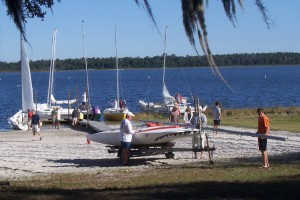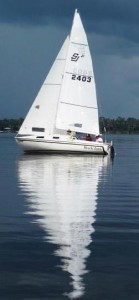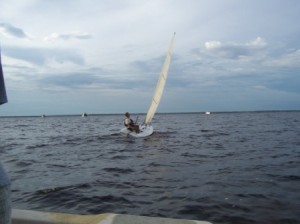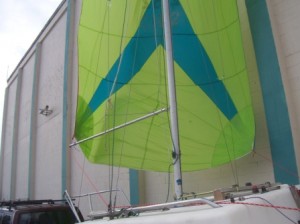Sunset Harbor Challenge 10/20/12 Ocala Sailing Club
Please Note that there are in fact three pages to this post, I wouldn’t want you to miss anything!
Ocala Sailing Club’s third annual Sunset Harbor Challenge certainly got the challenge part right.Thirty boats registered including ten boats from LMSA. Nearly ten miles of the most consistent inconsistencies I may have ever witnessed. I have heard that Ted Turner said something along the lines of “If you have not adjusted your sails in the last thirty seconds you are out of trim”. At this year’s Sunset Harbor Challenge thirty seconds would have allowed ten such opportunities to be out of trim.
We have come to expect these kinds of shifts when the wind is very light but in this case there was pretty good wind nearly the entire time. The other factor that made it unique was the amount of wind shear. Basically wind shear for a sailboat refers to the fact that the wind changes as the altitude changes, or the wind at the top of the mast is different than the wind at the spreaders which is different than the wind at the boom level. Wind shear variations on Lake Weir at this event were extreme.
If you are interested, there are some good explanations here. http://www.weatherquestions.com/What_is_wind_shear.htm, I especially liked this statement, “Wind shear in an atmospheric layer that is clear, but unstable, can result in clear air turbulence.” Based on the evidence provided on Lake Weir, I suggest this might be understated. Several good photos were taken and posted on Face Book at the link below. http://www.facebook.com/FriendsOfMarionCountyParksandRecreationFoundation, I am sure more photos will become available in the near future.
Lake Weir has been a large influence on my sailing history. My family started sailing on Lake Weir in the late 1980’s on a Mirage 5.5 named Hydromania when Ocala Sailing Club was a splinter group of the Ocala Beer and Rafting Society. My oldest son sailed on Lake Weir in his car seat when he was less than one and later rolled around in the V-berth while his mom jumped off the foredeck during a spinnaker douse. (She may have a slightly different perspective on that event). OSC provided the model for the LMSA Christmas gift exchange, which has become one of our premier social events. Ed Simms, Paul Straub, David Mooring, and John Hult are just a few of our long time friends from OSC and there are stories to be told about each. Unfortunately the current membership of OSC is so nice and friendly that it is difficult for me to impart my normally sarcastic and unruly descriptions. Wait a minute, Paul is still a member, I guess there is always an opportunity. Jan Schumacher is a member of OSC that I just met this weekend, but she is currently one of my very favorites because she subscribed to my website and I didn’t even have to beg!
At the ramp there are trees, large unforgiving but delightful shading oaks. Some things change slowly like the trees at the ramp. These trees are more than willing to shed leaves, limbs, Spanish moss, and broken mast parts on the deck of the unsuspecting, uninitiated, and uninformed. I believe everyone escaped this weekend with nothing more than leaves and moss.
Mike McKeown from the Crescent City Yacht Club and I have figured out different but equally effective techniques to avoid sailing our own boats. I take so long getting my own boat working and then whine about not having any input for an article that many of my friends have invited me to sail with them over the past months (thank you very much). Mike threatens to sail a Walker Bay 10 in the planing class so people loan him other boats to sail to avoid infinitely long handicap calculations. Mike’s ride for the Sunset Harbor challenge turned out to be a Sunfish provided by Ed Simms, which needed a little cleaning, and since I had mooched a ride myself on Andy and Diane Forrest’s Show Meit felt noble to help Mike clean and launch the fish.









